

Compact Muon Solenoid
LHC, CERN
| CMS-HIN-23-003 ; CERN-EP-2023-292 | ||
| Extracting the speed of sound in quark-gluon plasma with ultrarelativistic lead-lead collisions at the LHC | ||
| CMS Collaboration | ||
| 12 January 2024 | ||
| Rep. Prog. Phys. 87 (2024) 077801 | ||
| Abstract: Ultrarelativistic nuclear collisions create a strongly interacting state of hot and dense quark-gluon matter that exhibits a remarkable collective flow behavior with minimal viscous dissipation. To gain deeper insights into its intrinsic nature and fundamental degrees of freedom, we determine the speed of sound in an extended volume of quark-gluon plasma using lead-lead (PbPb) collisions at a center-of-mass energy per nucleon pair of 5.02 TeV. The data were recorded by the CMS experiment at the CERN LHC and correspond to an integrated luminosity of 0.607 nb$^{-1}$. The measurement is performed by studying the multiplicity dependence of the average transverse momentum of charged particles emitted in head-on PbPb collisions. Our findings reveal that the speed of sound in this matter is nearly half the speed of light, with a squared value of 0.241 $ \pm $ 0.002 (stat) $ \pm $ 0.016 (syst) in natural units. The effective medium temperature, estimated using the mean transverse momentum, is 219 $ \pm $ 8 (syst) MeV. The measured squared speed of sound at this temperature aligns precisely with predictions from lattice quantum chromodynamic (QCD) calculations. This result provides a stringent constraint on the equation of state of the created medium and direct evidence for a deconfined QCD phase being attained in relativistic nuclear collisions. | ||
| Links: e-print arXiv:2401.06896 [hep-ex] (PDF) ; CDS record ; inSPIRE record ; HepData record ; Physics Briefing ; CADI line (restricted) ; | ||
| Figures | Summary | Additional Figures | References | CMS Publications |
|---|
| Figures | |
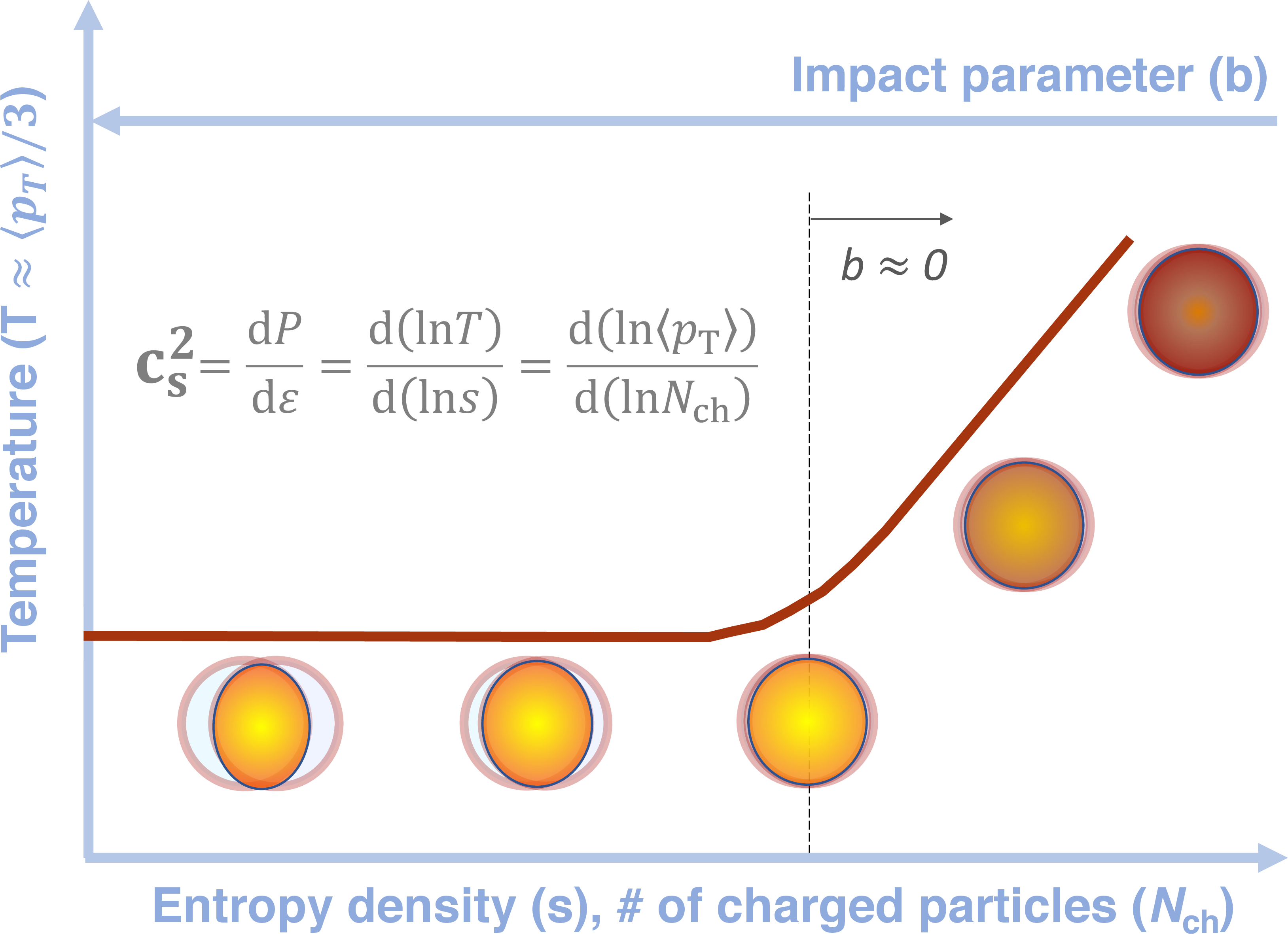
png pdf |
Figure 1:
Conceptual representation of temperature vs. entropy density from mid-central to ultra-central heavy ion collisions. |
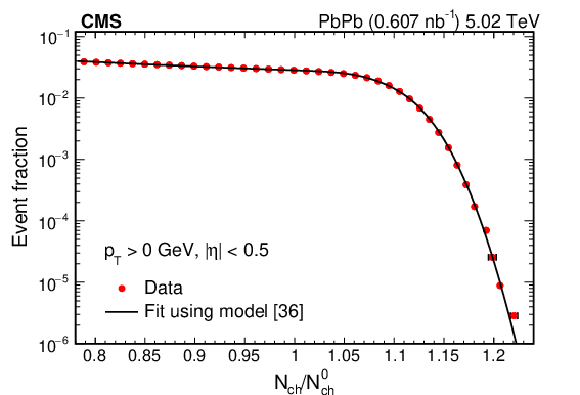
png pdf |
Figure 2:
The event fraction distribution as a function of the charged-particle multiplicity, $ N_{\text{ch}} $, within the kinematic range of $ |\eta| < $ 0.5 and extrapolated to the full $ p_{\mathrm{T}} $ range, in PbPb collisions at $ \sqrt{\smash[b]{s_{_{\mathrm{NN}}}}}= $ 5.02 TeV. The $ N_{\text{ch}} $ value is normalized by its value in the 0-5% centrality class ($ N_{\text{ch}}^{0} $). The curve represents a fit to the data using the S. Das et al. model [39]. |

png pdf |
Figure 3:
The average transverse momentum of charged particles, $ \langle {p_{\mathrm{T}}} \rangle $, as a function of the charged-particle multiplicity, $ N_{\text{ch}} $, within the kinematic range of $ |\eta| < $ 0.5 and extrapolated to the full $ p_{\mathrm{T}} $ range in PbPb collisions at $ \sqrt{\smash[b]{s_{_{\mathrm{NN}}}}}= $ 5.02 TeV. Both $ \langle {p_{\mathrm{T}}} \rangle $ and $ N_{\text{ch}} $ are normalized by their values in the 0-5% centrality class ($ \langle {p_{\mathrm{T}}} \rangle^{0} $ and $ N_{\text{ch}}^{0} $). Bars and the red band correspond to statistical and systematic uncertainties, respectively. Hydrodynamic simulations from the TRAJECTUM model [19] and the model by Gardim et al. [17] are also shown for comparison. The dashed line is a fit to the data using Eq. (2) in the range of $ N_{\text{ch}}/N_{\text{ch}}^{0} > $ 1.14. |
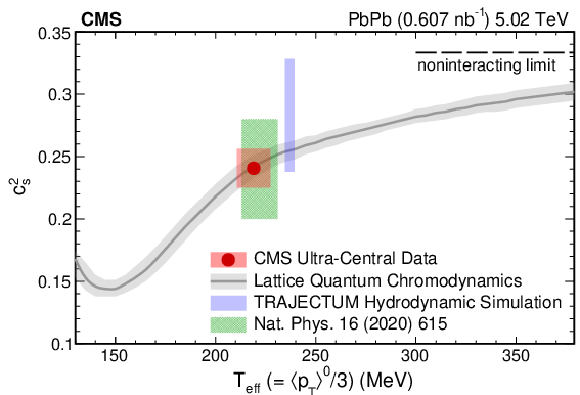
png pdf |
Figure 4:
The speed of sound, $ c^2_{\mathrm{s}} $, as a function of the effective temperature, $ T_{\text{eff}} $, with the CMS data point obtained from ultra-central PbPb collision data at $ \sqrt{\smash[b]{s_{_{\mathrm{NN}}}}}= $ 5.02 TeV. The size of the red box indicates systematic uncertainties of $ c^2_{\mathrm{s}} $ and $ T_{\text{eff}} $, while statistical uncertainties are smaller than the marker size. Values extracted from the TRAJECTUM simulation [19] following the same fitting procedure as the data and from the earlier work [16] are presented as the other colored boxes. The curve shows the prediction of $ c^2_{\mathrm{s}} $ as a function of $ T $ from lattice QCD calculations [6]. The dashed line at the value of 1/3 corresponds to the upper limit for noninteracting, massless gas (``ideal gas'') systems [42]. |
| Summary |
| In summary, this study presents a measurement with a new hydrodynamic probe in ultrarelativistic nuclear collisions that results in the most precise determination to date of the speed of sound in an extended volume of quark-gluon plasma matter. By determining the dependence of the average transverse momentum on the total multiplicity for charged particles in nearly head-on lead-lead collisions at a center-of-mass energy per nucleon pair of 5.02 TeV, a squared speed of sound of 0.241 $ \pm $ 0.002 (stat) $ \pm $ 0.016 (syst) in natural units is determined. The effective medium temperature, estimated using the mean transverse momentum, is 219 $ \pm $ 8 (syst) MeV. The excellent agreement of lattice quantum chromodynamics predictions with the experimental results provides strong evidence for the existence of a deconfined phase of matter at extremely high temperatures. |
| Additional Figures | |
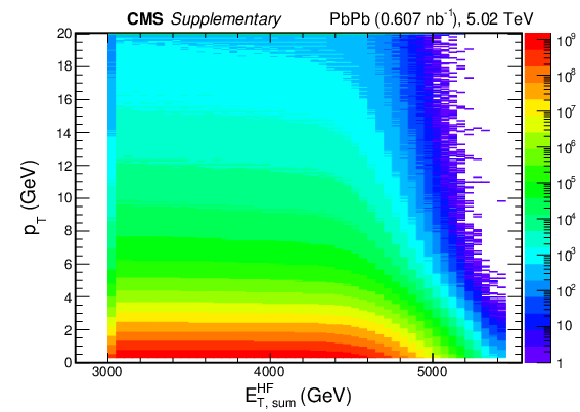
png pdf |
Additional Figure 1:
Charged particle transverse momentum $ p_{\mathrm{T}} $, measured within pseudorapidity $ |\eta| < $ 0.5 and for $ p_{\mathrm{T}} > $ 0.3 GeV, as a function of total HF transverse energy sum $ E_{\mathrm{T, sum}}^{\mathrm{HF}} $ in PbPb collisions (0-10% centrality class) at a nucleon-nucleon center-of-mass energy of 5.02 TeV. |

png pdf |
Additional Figure 2:
The transverse momentum $ p_{\mathrm{T}} $ spectrum generated by the HYDJET event generator, with a curve superimposed on it representing the Hageborn function [38] fitted in the range $ p_{\mathrm{T}} > $ 0.4 GeV, and extrapolated to $ p_{\mathrm{T}} < $ 0.4 GeV in PbPb collisions (0-5% centrality class) at a nucleon-nucleon center-of-mass energy of 5.02 TeV. The mean $ p_{\mathrm{T}} $ value from the HYDJET event generator is $ \langle p_\mathrm{T} \rangle= $ 0.700 GeV, while the extrapolated one is $ \langle p_\mathrm{T} \rangle= $ 0.703 GeV. |
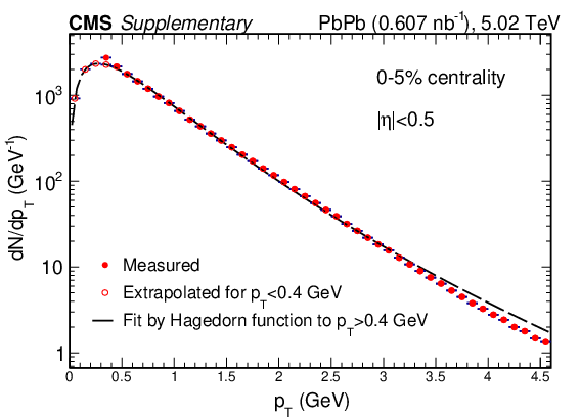
png pdf |
Additional Figure 3:
The measured transverse momentum $ p_{\mathrm{T}} $ spectrum (solid markers) fitted by the Hagedorn function [38] in the range $ p_{\mathrm{T}} > $ 4.0 GeV and extrapolated to $ p_{\mathrm{T}} < $ 0.4 GeV (open circles) in PbPb collisions (0-5% centrality class) at a nucleon-nucleon center-of-mass energy of 5.02 TeV. |

png pdf |
Additional Figure 4:
The average transverse momentum of charged particles, $ \langle p_\mathrm{T} \rangle $, as a function of the charged particle multiplicity, $ N_{\mathrm{ch}} $, within the kinematic range of pseudorapidity $ |\eta| < $ 0.5 and $ p_{\mathrm{T}} > $ 0.3 GeV, in PbPb collisions at a nucleon-nucleon center-of-mass energy of 5.02 TeV. Both $ \langle p_\mathrm{T} \rangle $ and $ N_{\mathrm{ch}} $ are normalized by their values in the 0-5% centrality class. Bars and red bands correspond to statistical and systematic uncertainties, respectively. Hydrodynamic simulations from the Trajectum model [19] and model by Gardim et. al. [17] are also shown for comparison. |
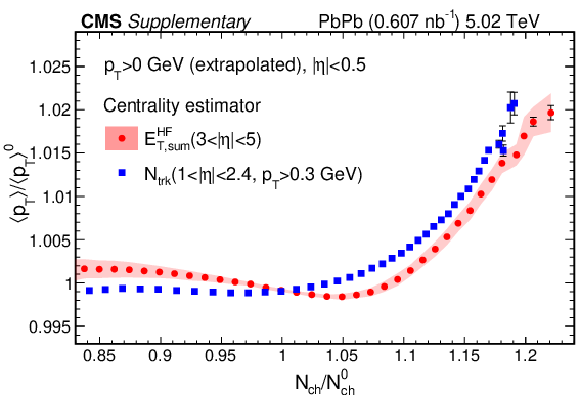
png pdf |
Additional Figure 5:
The average transverse momentum of charged particles, $ \langle p_\mathrm{T} \rangle $, as a function of the charged particle multiplicity, $ N_{\mathrm{ch}} $, within the kinematic range of pseudorapidity $ |\eta| < $ 0.5 and $ p_{\mathrm{T}} > $ 0.3 GeV, in PbPb collisions at a nucleon-nucleon center-of-mass energy of 5.02 TeV. Results are obtained with different centrality estimators based on the total HF transverse energy sum with 3 $ < |\eta| < $ 5 (red circles) and charged track multiplicity with 1 $ < |\eta| < $ 2.4 and $ p_{\mathrm{T}} > $ 0.3 GeV (blue squares). Both $ \langle p_\mathrm{T} \rangle $ and $ N_{\mathrm{ch}} $ are normalized by their values in the 0-5% centrality class. Bars and red bands correspond to statistical and systematic uncertainties, respectively. |

png pdf |
Additional Figure 6:
The average transverse momentum of charged particles, $ \langle p_\mathrm{T} \rangle $, as a function of the charged particle multiplicity, $ N_{\mathrm{ch}} $, within the kinematic range of pseudorapidity $ |\eta| < $ 0.5 and $ p_{\mathrm{T}} > $ 0.3 GeV, in PbPb collisions at a nucleon-nucleon center-of-mass energy of 5.02 TeV. Results are obtained with different centrality estimators based on the total HF transverse energy sum with 3 $ < |\eta| < $ 5 (red circles) and charged track multiplicity with 1 $ < |\eta| < $ 2.4 and $ p_{\mathrm{T}} > $ 0.3 GeV (blue squares). Both $ \langle p_\mathrm{T} \rangle $ and $ N_{\mathrm{ch}} $ are normalized by their values in the 0-5% centrality class. Bars and red bands correspond to statistical and systematic uncertainties, respectively. |
| References | ||||
| 1 | E. V. Shuryak | Theory of hadronic plasma | Sov. Phys. JETP 47 (1978) 212 | |
| 2 | J. C. Collins and M. J. Perry | Superdense matter: neutrons or asymptotically free quarks? | PRL 34 (1975) 1353 | |
| 3 | N. Cabibbo and G. Parisi | Exponential hadronic spectrum and quark liberation | PLB 59 (1975) 67 | |
| 4 | B. A. Freedman and L. D. McLerran | Fermions and gauge vector mesons at finite temperature and density. 3. the ground state energy of a relativistic quark gas | PRD 16 (1977) 1169 | |
| 5 | R. C. Hwa and X. N. Wang, eds. | Quark-gluon plasma 3 | World Scientific, Singapore, ISBN~978-981-238-077-7, 978-981-4488-08-2, 2004 link |
|
| 6 | HotQCD Collaboration | Equation of state in (2+1)-flavor QCD | PRD 90 (2014) 094503 | 1407.6387 |
| 7 | STAR Collaboration | Experimental and theoretical challenges in the search for the quark gluon plasma: The STAR collaboration's critical assessment of the evidence from RHIC collisions | Nucl. Phys. A 757 (2005) 102 | nucl-ex/0501009 |
| 8 | PHENIX Collaboration | Formation of dense partonic matter in relativistic nucleus-nucleus collisions at RHIC: experimental evaluation by the PHENIX collaboration | Nucl. Phys. A 757 (2005) 184 | nucl-ex/0410003 |
| 9 | BRAHMS Collaboration | Quark gluon plasma and color glass condensate at RHIC? The perspective from the BRAHMS experiment | Nucl. Phys. A 757 (2005) 1 | nucl-ex/0410020 |
| 10 | PHOBOS Collaboration | The PHOBOS perspective on discoveries at RHIC | Nucl. Phys. A 757 (2005) 28 | nucl-ex/0410022 |
| 11 | U. Heinz and R. Snellings | Collective flow and viscosity in relativistic heavy-ion collisions | Ann. Rev. Nucl. Part. Sci. 63 (2013) 123 | 1301.2826 |
| 12 | J. Joseph et al. | Measurement of sound velocity in a Fermi gas near a Feshbach resonance | PRL 98 (2007) 170401 | |
| 13 | P. B. Patel et al. | Universal sound diffusion in a strongly interacting Fermi gas | Science 370 (2020) 1222 | 1909.02555 |
| 14 | R. Campanini and G. Ferri | Experimental equation of state in proton-proton and proton-antiproton collisions and phase transition to quark gluon plasma | PLB 703 (2011) 237 | 1106.2008 |
| 15 | S. Pratt, E. Sangaline, P. Sorensen, and H. Wang | Constraining the equation of state of super-hadronic matter from heavy-ion collisions | PRL 114 (2015) 202301 | 1501.04042 |
| 16 | F. G. Gardim, G. Giacalone, M. Luzum, and J.-Y. Ollitrault | Thermodynamics of hot strong-interaction matter from ultrarelativistic nuclear collisions | Nature Phys. 16 (2020) 615 | 1908.09728 |
| 17 | F. G. Gardim, G. Giacalone, and J.-Y. Ollitrault | The mean transverse momentum of ultracentral heavy-ion collisions: A new probe of hydrodynamics | PLB 809 (2020) 135749 | 1909.11609 |
| 18 | A. Sorensen, D. Oliinychenko, V. Koch, and L. McLerran | Speed of sound and baryon cumulants in heavy-ion collisions | PRL 127 (2021) 042303 | 2103.07365 |
| 19 | G. Nijs and W. van der Schee | Predictions and postdictions for relativistic lead and oxygen collisions with the computational simulation code Trajectum | Phys. Rev. C 106 (2022) 044903 | 2110.13153 |
| 20 | Z. Qiu, C. Shen, and U. W. Heinz | Resonance decay contributions to higher-order anisotropic flow coefficients | Phys. Rev. C 86 (2012) 064906 | 1210.7010 |
| 21 | CMS Collaboration | HEPData record for this analysis | link | |
| 22 | CMS Collaboration | The CMS experiment at the CERN LHC | JINST 3 (2008) S08004 | |
| 23 | CMS Collaboration | Performance of the CMS level-1 trigger in proton-proton collisions at $ \sqrt{s} = $ 13 TeV | JINST 15 (2020) P10017 | CMS-TRG-17-001 2006.10165 |
| 24 | CMS Collaboration | The CMS trigger system | JINST 12 (2017) P01020 | CMS-TRG-12-001 1609.02366 |
| 25 | CMS Collaboration | Electron and photon reconstruction and identification with the CMS experiment at the CERN LHC | JINST 16 (2021) P05014 | CMS-EGM-17-001 2012.06888 |
| 26 | CMS Collaboration | Performance of the CMS muon detector and muon reconstruction with proton-proton collisions at $ \sqrt{s}= $ 13 TeV | JINST 13 (2018) P06015 | CMS-MUO-16-001 1804.04528 |
| 27 | CMS Collaboration | Description and performance of track and primary-vertex reconstruction with the CMS tracker | JINST 9 (2014) P10009 | CMS-TRK-11-001 1405.6569 |
| 28 | CMS Collaboration | Particle-flow reconstruction and global event description with the CMS detector | JINST 12 (2017) P10003 | CMS-PRF-14-001 1706.04965 |
| 29 | G. Bayatian et al. | Design, performance and calibration of the CMS forward calorimeter wedges | EPJC 53 (2008) 139 | |
| 30 | O. Suranyi et al. | Performance of the CMS zero degree calorimeters in pPb collisions at the LHC | JINST 16 (2021) P05008 | 2102.06640 |
| 31 | CMS Collaboration | Charged-particle nuclear modification factors in PbPb and pPb collisions at $ \sqrt{\smash[b]{s_{_{\mathrm{NN}}}}} = $ 5.02 TeV | JHEP 04 (2017) 039 | CMS-HIN-15-015 1611.01664 |
| 32 | CMS Collaboration | Studies of azimuthal dihadron correlations in ultra-central PbPb collisions at $ \sqrt{\smash[b]{s_{_{\mathrm{NN}}}}} = $ 2.76 TeV | JHEP 02 (2014) 088 | CMS-HIN-12-011 1312.1845 |
| 33 | CMS Collaboration | Mixed higher-order anisotropic flow and nonlinear response coefficients of charged particles in PbPb collisions at $ \sqrt{\smash[b]{s_{_{\mathrm{NN}}}}} = $ 2.76 and 5.02 TeV | EPJC 80 (2020) 534 | CMS-HIN-17-005 1910.08789 |
| 34 | I. P. Lokhtin et al. | Heavy ion event generator HYDJET++ (HYDrodynamics plus JETs) | Comput. Phys. Commun. 180 (2009) 779 | 0809.2708 |
| 35 | GEANT4 Collaboration | GEANT4---a simulation toolkit | NIM A 506 (2003) 250 | |
| 36 | R. Hagedorn | Multiplicities, $ p_{\mathrm{T}} $ distributions and the expected hadron to quark-gluon phase transition | 1, 1983 Riv. Nuovo Cim. 6 (1983) N10 |
|
| 37 | ALICE Collaboration | Transverse momentum spectra and nuclear modification factors of charged particles in Xe-Xe collisions at $ \sqrt{\smash[b]{s_{_{\mathrm{NN}}}}} = $ 5.44 TeV | PLB 788 (2019) 166 | 1805.04399 |
| 38 | ALICE Collaboration | Centrality dependence of the charged-particle multiplicity density at midrapidity in Pb-Pb collisions at $ \sqrt{\smash[b]{s_{_{\mathrm{NN}}}}} = $ 5.02 TeV | PRL 116 (2016) 222302 | 1512.06104 |
| 39 | S. J. Das, G. Giacalone, P.-A. Monard, and J.-Y. Ollitrault | Relating centrality to impact parameter in nucleus-nucleus collisions | Phys. Rev. C 97 (2018) 014905 | 1708.00081 |
| 40 | G. Giacalone, G. Nijs, and W. van der Schee | Determination of the neutron skin of Pb208 from ultrarelativistic nuclear collisions | PRL 131 (2023) 202302 | 2305.00015 |
| 41 | G. Nijs and W. van der Schee | Ultracentral heavy ion collisions, transverse momentum and the equation of state | 2312.04623 | |
| 42 | S. Borsanyi et al. | The QCD equation of state with dynamical quarks | JHEP 11 (2010) 077 | 1007.2580 |

|
Compact Muon Solenoid LHC, CERN |

|

|

|

|

|

|